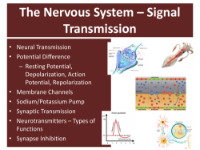Action Potential in the Neuron
Video
Science
+1
Science
11th Grade - 12th Grade
Premium

H
Harvard Extension School
Science Resource Description
This animation demonstrates the behavior of a typical neuron at its resting membrane potential, and when it reaches an action potential and fires, transmitting an electrochemical signal along the axon. It shows how the various components work in concert: Dendrites, cell body, axon, sodium and potassium ions, voltage-gated ion channels, the sodium-potassium pump, and myelin sheaths. It also shows the stages of an action potential: Polarization, depolarization, and hyperpolarization.
The animation was co-developed by Harvard Extension School's Office of Digital Teaching and Learning, and instructors for the courses in neurobiology and human anatomy.
Learn more about Harvard Extension School: https://www.extension.harvard.edu/?utm_source=youtube&utm_medium=social&utm_campaign=ext_action-potential-in-the-neuron&utm_content=description
Explore other content in this scheme
Part of a lesson by Teach with Fergy
Other resources in this lesson

2-Minute Neuroscience: Synaptic Transmission
Resource
Science
+1
11th Grade - 12th Grade

The Schwann Cell and Action Potential
Resource
Science
+1
11th Grade - 12th Grade

2-Minute Neuroscience: Sodium-Potassium Pump
Resource
Science
+1
11th Grade - 12th Grade

2-Minute Neuroscience: Neurotransmitter Release
Resource
Science
+1
11th Grade - 12th Grade

The Chemical Mind: Crash Course Psychology #3
Resource
Science
+1
11th Grade - 12th Grade

The Nervous System - Signal Transmission - Exit Ticket
Resource
Science
+1
11th Grade - 12th Grade

The Nervous System - Signal Transmission - Student Lesson Outline
Resource
Science
+1
11th Grade - 12th Grade

The Nervous System - Signal Transmission - Student Presentation
Resource
Science
+1
11th Grade - 12th Grade

The Nervous System - Signal Transmission - Teaching Presentation
Resource
Science
+1
11th Grade - 12th Grade
